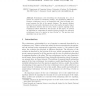BIOINFORMATICS
2002
15 years 18 days ago
2002
Reconstructing evolutionary trees is an important problem in biology. A response to the computational intractability of most of the traditional criteria for inferring evolutionary...
118
Voted
BMCBI
2008
15 years 27 days ago
2008
Background: Inference of evolutionary trees using the maximum likelihood principle is NP-hard. Therefore, all practical methods rely on heuristics. The topological transformations...
107
Voted
METMBS
2004
15 years 2 months ago
2004
We introduce new distance measures for the construction and analysis of phylogenies, focusing on thioredoxin-fold proteins. Our distance measures for tree construction are based o...
89
Voted
NIPS
2008
15 years 2 months ago
2008
Accurate and efficient inference in evolutionary trees is a central problem in computational biology. While classical treatments have made unrealistic site independence assumption...
88
Voted
STOC
1996
ACM
15 years 4 months ago
1996
ACM
Abstract. Most phylogenetics literature and construction methods based upon characters presume monomorphism (one state per character per species), yet polymorphism (multiple states...
110
click to vote
ISAAC
2001
Springer
15 years 5 months ago
2001
Springer
Evolutionary trees describing the relationship for a set of species are central in evolutionary biology, and quantifying differences between evolutionary trees is an important tas...
105
Voted
BIBM
2008
IEEE
15 years 7 months ago
2008
IEEE
We present new and novel insights into the behavior of two maximum parsimony heuristics for building evolutionary trees of different sizes. First, our results show that the heuris...
117
Voted
BICOB
2009
Springer
15 years 7 months ago
2009
Springer
Phylogenetics is concerned with inferring the genealogical relationships between a group of organisms (or taxa), and this relationship is usually expressed as an evolutionary tree....
99
Voted
LATA
2009
Springer
15 years 7 months ago
2009
Springer
Abstract. Gene trees are leaf-labeled trees inferred from molecular sequences. Due to duplication events arising in genome evolution, gene trees usually have multiple copies of som...



